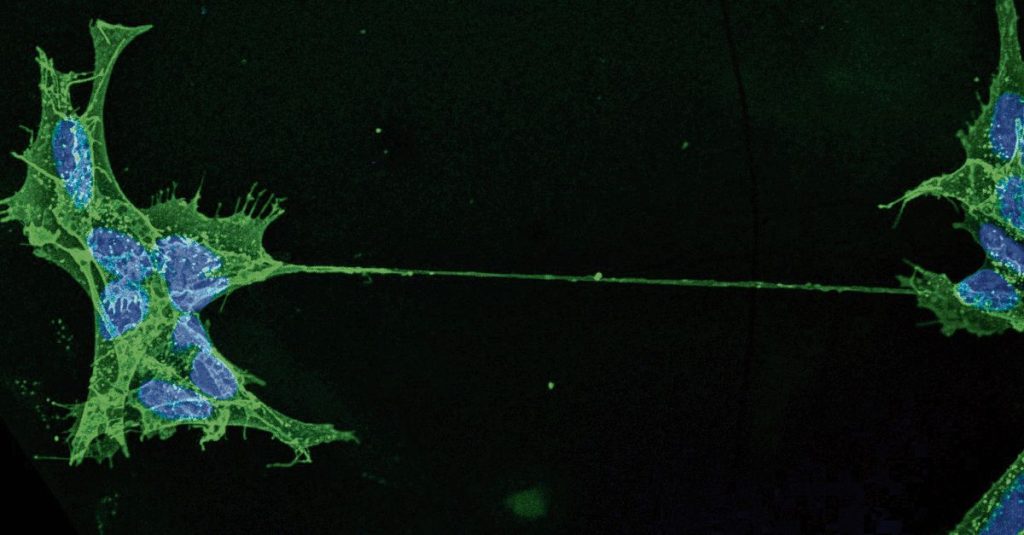The SARS-CoV-2 coronavirus can spread from cell to cell through microscopic junctions between cells, digging nanotubes (TNT). This may be a mechanism that may explain how SARS-CoV-2 can enter the brain, despite the fact that most brain cells lack the necessary ACE-2 receptors on their surface. Virus on his back on TNT links. who – which Writing by researchers Anna Bibi and Chiara Zorzulo at the Pasteur Institute in Paris science progress.
Other researchers have previously shown the presence of SARS-CoV-2 virus in the brain of a deceased Covid patient. In addition, it is also known that corona infection can cause many neurological symptoms, ranging from fatigue and problems concentrating to loss of smell and taste. But it was a mystery how the coronavirus was able to infect nerve cells, most of which lack angiotensin-converting enzyme 2 receptors.
thin branches
Zurzolo’s research group decided to see if the infection could be transmitted from lung cells to neurons via micro nanotubes. These are thin, elongated extensions of the cell connecting them. Previous research has already demonstrated that other viruses, including HIV, herpes and influenza virus, can travel to other cells through these tubes. An alternative method of infection, which in this case will also make it possible for the corona to infect cells that do not have ACE-2 receptors.
In their experiments, the researchers showed that the cultured neurons did not become infected when they added SARS-CoV-2. Lung cells that have many ACE2 receptors on their surface have become infected. But if the researchers grow both types of cells together in one container and add a virus, the neurons become infected. The same experiment with the remaining dead lung cells did not result in neuronal injury, an indication that virus transmission must be an active process that requires living lung cells.
More research has also shown that infection with SARS-CoV-2 stimulates lung cells to produce more TNTs. They made it more amongst themselves, but also with brain cells if they were in the same container.
One of the researchers on the team is Dutchman Matin Voss, who specializes in cryo-electron microscopy. “With this technology, we can do a CT scan of the cells, as it were, so we can see very precisely what’s going on in and around the TNTs. And so we can see that TNT has already formed between lung cells and brain cells. And that there was in some Sometimes viral particles are on and in the TNT ones.”
Read an interview with cryo-microbiologist Zfiya Ze’ev Ben Mordechai: ‘I find it cool, this simplicity in the sperm cell’
for nerve cells
It is not yet clear how the infection can travel through the nanotubes from lung cells to nerve cells. “The name digging tunnels The nanotubes suggest that the virus or its parts pass through it. Through the tunnel, the open junction between two cells, the genetic material of the virus can move, but also virus factories, a group of virus proteins, or even whole virus particles. But the point is that it doesn’t have to go through the tube. We occasionally see the virus in the tunnel, but we don’t know if it really goes through that way.”
Another possibility, Vos says, is: “We also saw virus particles on the outside of the tubes. This may indicate that the ACE2 receptor travels from the lung cell through the tube membrane to the neuron. As a result, the neuron remains receptive to SARS-CoV-2.” .
To find out how the infection is transmitted, the researchers would like to follow the transmission of live coronavirus via a “live broadcast” of TNT. But this is only possible using the microscope located in the BSL-3 laboratory. Vos explains that this is a laboratory with a very strict safety regime, and is still required to work with SARS-CoV-2. “Globally, there are only a few microscopes in such a very safe laboratory and access is very limited. We hope to start building our own facility next year.”
A version of this article also appeared in the July 21, 2022 newspaper

“Total coffee specialist. Hardcore reader. Incurable music scholar. Web guru. Freelance troublemaker. Problem solver. Travel trailblazer.”







More Stories
Toward a sustainable future: space exploration as a driver of terrestrial sustainability
“There is no scientific evidence for strict fertilizer standards in the Netherlands.”
Astronomers have discovered a new molecule in space. And it's very special